Market Entry Strategies and Sustainable Advantage
VerifiedAdded on 2020/10/05
|15
|4307
|491
AI Summary
The provided assignment discusses various marketing concepts, including market entry strategies, PESTLE analysis, market segmentation, market targeting, and Porter's generic strategies. It aims to help businesses achieve sustainable and competitive advantage in their respective markets.
Contribute Materials
Your contribution can guide someone’s learning journey. Share your
documents today.
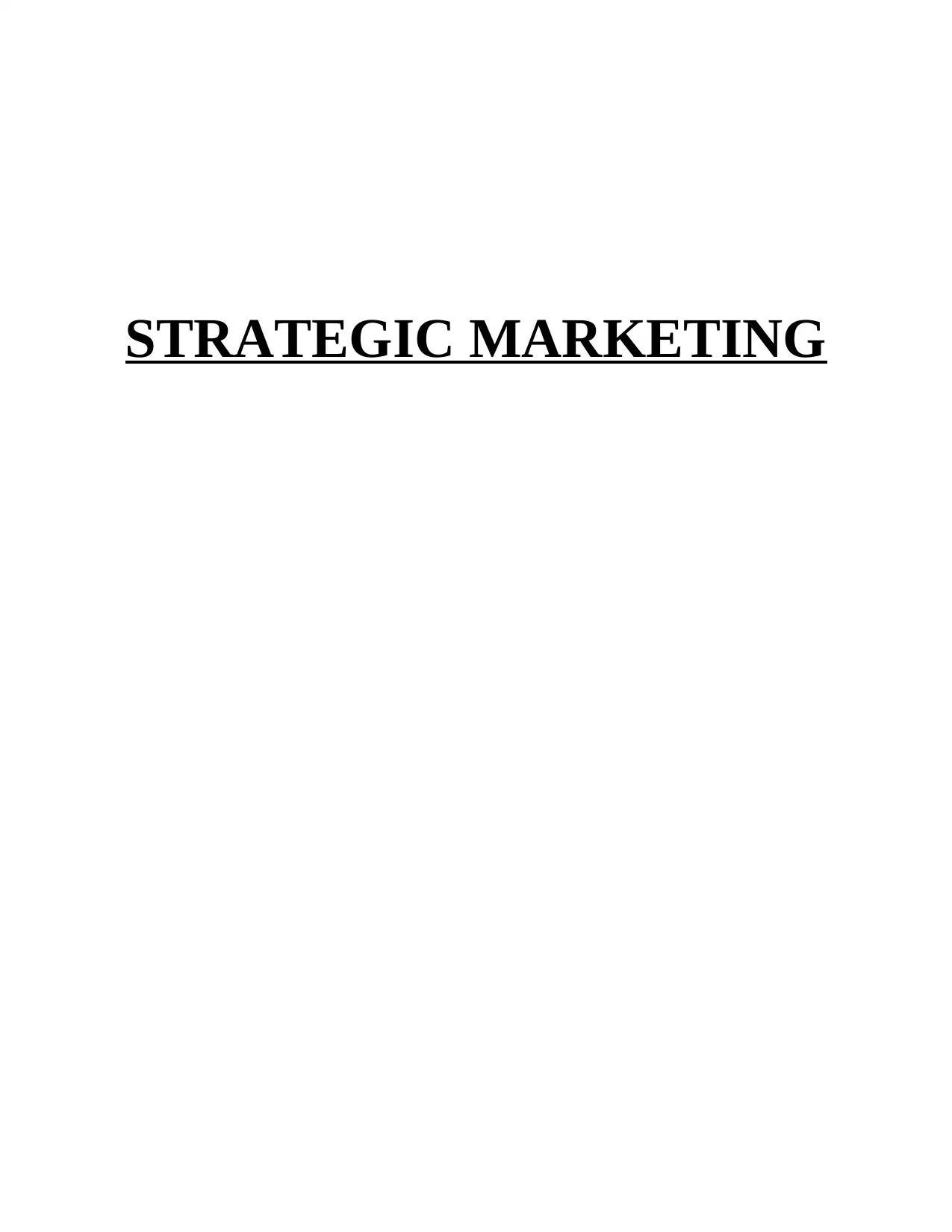
STRATEGIC MARKETING
Secure Best Marks with AI Grader
Need help grading? Try our AI Grader for instant feedback on your assignments.
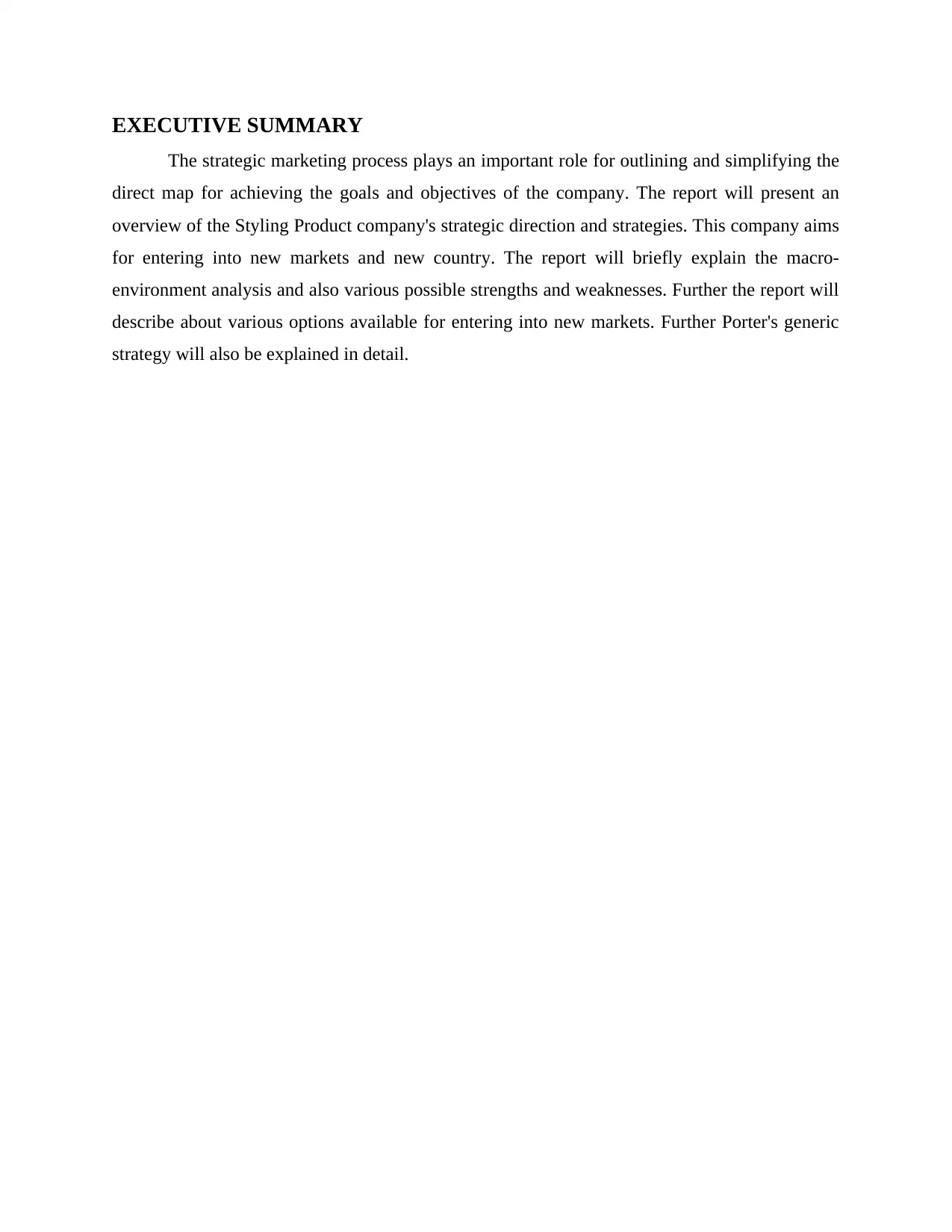
EXECUTIVE SUMMARY
The strategic marketing process plays an important role for outlining and simplifying the
direct map for achieving the goals and objectives of the company. The report will present an
overview of the Styling Product company's strategic direction and strategies. This company aims
for entering into new markets and new country. The report will briefly explain the macro-
environment analysis and also various possible strengths and weaknesses. Further the report will
describe about various options available for entering into new markets. Further Porter's generic
strategy will also be explained in detail.
The strategic marketing process plays an important role for outlining and simplifying the
direct map for achieving the goals and objectives of the company. The report will present an
overview of the Styling Product company's strategic direction and strategies. This company aims
for entering into new markets and new country. The report will briefly explain the macro-
environment analysis and also various possible strengths and weaknesses. Further the report will
describe about various options available for entering into new markets. Further Porter's generic
strategy will also be explained in detail.
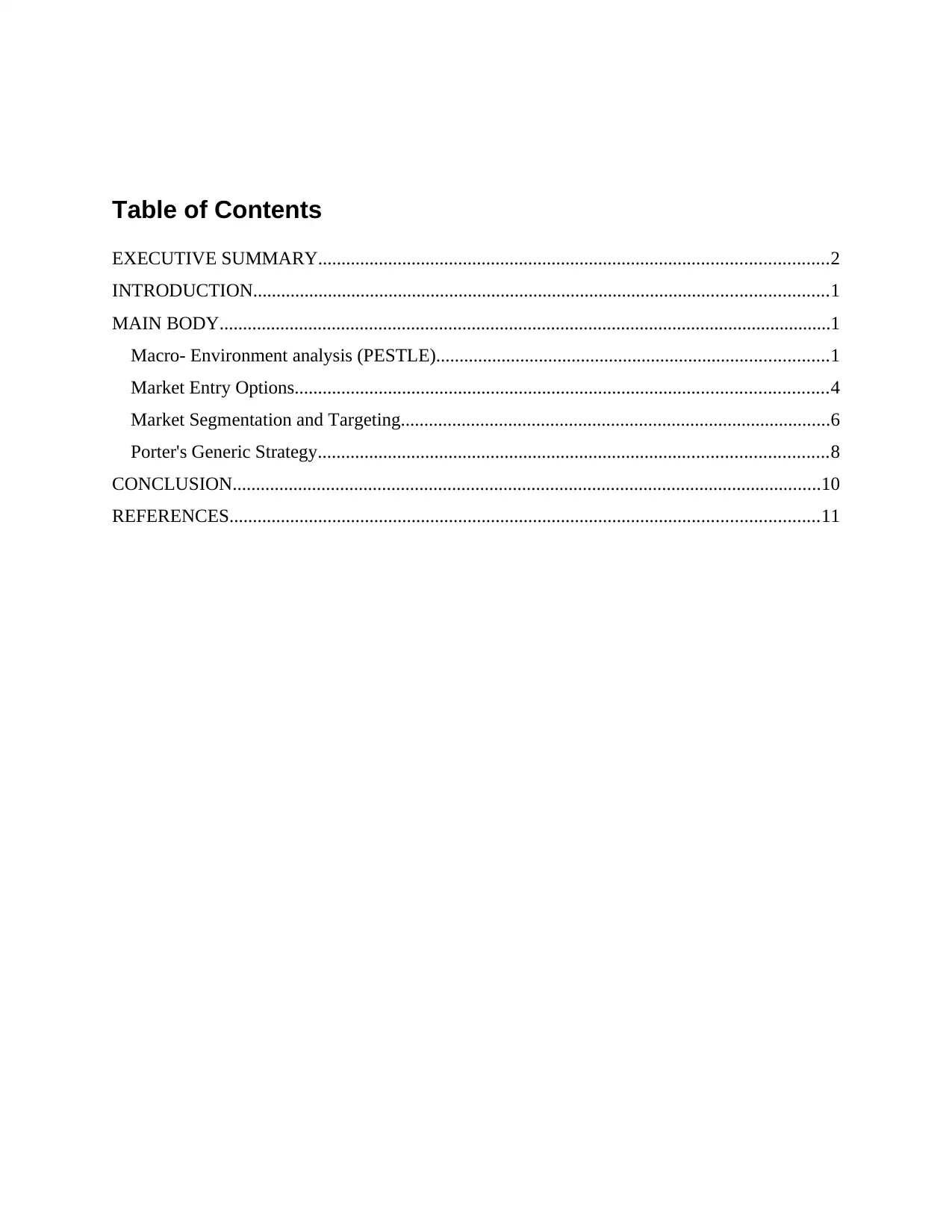
Table of Contents
EXECUTIVE SUMMARY.............................................................................................................2
INTRODUCTION...........................................................................................................................1
MAIN BODY...................................................................................................................................1
Macro- Environment analysis (PESTLE)....................................................................................1
Market Entry Options..................................................................................................................4
Market Segmentation and Targeting............................................................................................6
Porter's Generic Strategy.............................................................................................................8
CONCLUSION..............................................................................................................................10
REFERENCES..............................................................................................................................11
EXECUTIVE SUMMARY.............................................................................................................2
INTRODUCTION...........................................................................................................................1
MAIN BODY...................................................................................................................................1
Macro- Environment analysis (PESTLE)....................................................................................1
Market Entry Options..................................................................................................................4
Market Segmentation and Targeting............................................................................................6
Porter's Generic Strategy.............................................................................................................8
CONCLUSION..............................................................................................................................10
REFERENCES..............................................................................................................................11
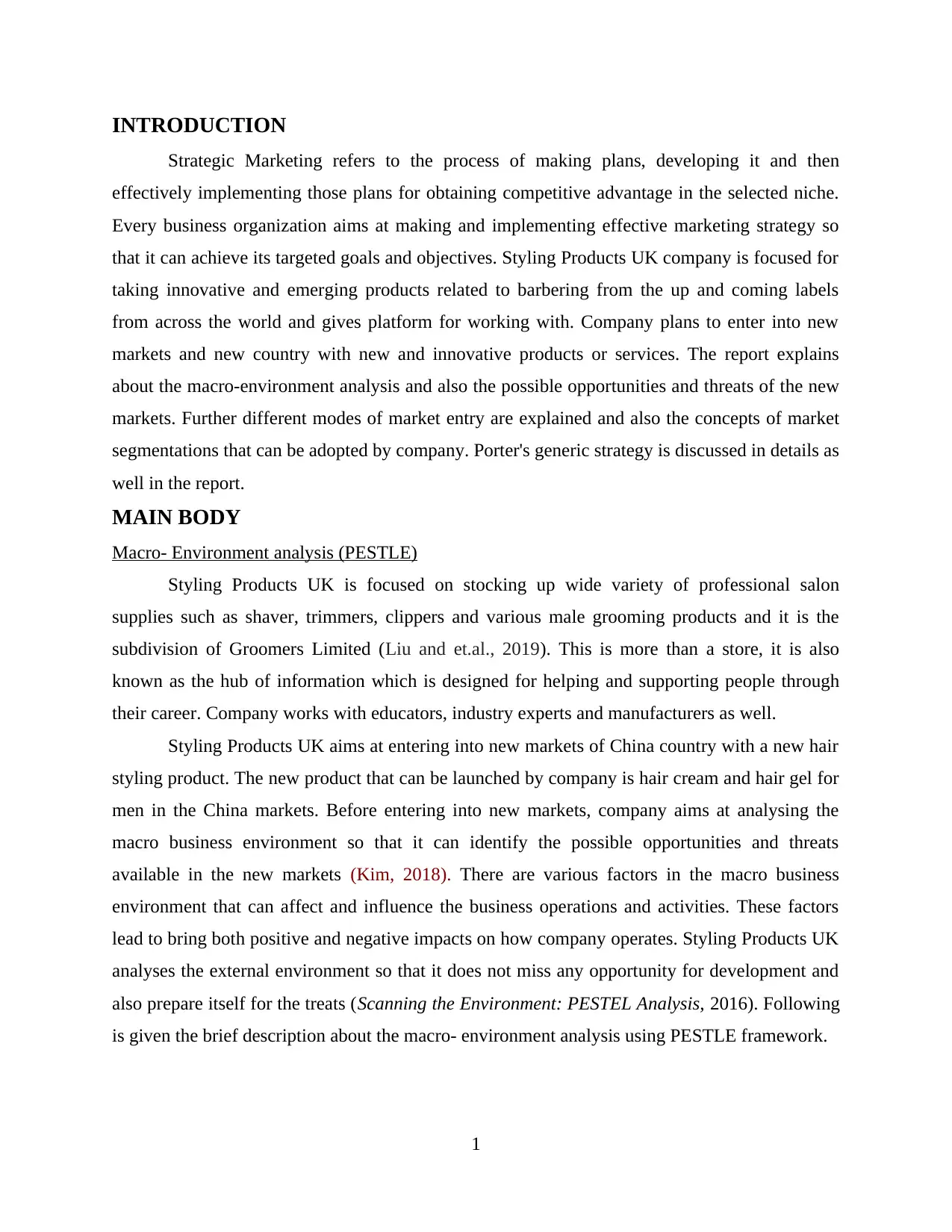
INTRODUCTION
Strategic Marketing refers to the process of making plans, developing it and then
effectively implementing those plans for obtaining competitive advantage in the selected niche.
Every business organization aims at making and implementing effective marketing strategy so
that it can achieve its targeted goals and objectives. Styling Products UK company is focused for
taking innovative and emerging products related to barbering from the up and coming labels
from across the world and gives platform for working with. Company plans to enter into new
markets and new country with new and innovative products or services. The report explains
about the macro-environment analysis and also the possible opportunities and threats of the new
markets. Further different modes of market entry are explained and also the concepts of market
segmentations that can be adopted by company. Porter's generic strategy is discussed in details as
well in the report.
MAIN BODY
Macro- Environment analysis (PESTLE)
Styling Products UK is focused on stocking up wide variety of professional salon
supplies such as shaver, trimmers, clippers and various male grooming products and it is the
subdivision of Groomers Limited (Liu and et.al., 2019). This is more than a store, it is also
known as the hub of information which is designed for helping and supporting people through
their career. Company works with educators, industry experts and manufacturers as well.
Styling Products UK aims at entering into new markets of China country with a new hair
styling product. The new product that can be launched by company is hair cream and hair gel for
men in the China markets. Before entering into new markets, company aims at analysing the
macro business environment so that it can identify the possible opportunities and threats
available in the new markets (Kim, 2018). There are various factors in the macro business
environment that can affect and influence the business operations and activities. These factors
lead to bring both positive and negative impacts on how company operates. Styling Products UK
analyses the external environment so that it does not miss any opportunity for development and
also prepare itself for the treats (Scanning the Environment: PESTEL Analysis, 2016). Following
is given the brief description about the macro- environment analysis using PESTLE framework.
1
Strategic Marketing refers to the process of making plans, developing it and then
effectively implementing those plans for obtaining competitive advantage in the selected niche.
Every business organization aims at making and implementing effective marketing strategy so
that it can achieve its targeted goals and objectives. Styling Products UK company is focused for
taking innovative and emerging products related to barbering from the up and coming labels
from across the world and gives platform for working with. Company plans to enter into new
markets and new country with new and innovative products or services. The report explains
about the macro-environment analysis and also the possible opportunities and threats of the new
markets. Further different modes of market entry are explained and also the concepts of market
segmentations that can be adopted by company. Porter's generic strategy is discussed in details as
well in the report.
MAIN BODY
Macro- Environment analysis (PESTLE)
Styling Products UK is focused on stocking up wide variety of professional salon
supplies such as shaver, trimmers, clippers and various male grooming products and it is the
subdivision of Groomers Limited (Liu and et.al., 2019). This is more than a store, it is also
known as the hub of information which is designed for helping and supporting people through
their career. Company works with educators, industry experts and manufacturers as well.
Styling Products UK aims at entering into new markets of China country with a new hair
styling product. The new product that can be launched by company is hair cream and hair gel for
men in the China markets. Before entering into new markets, company aims at analysing the
macro business environment so that it can identify the possible opportunities and threats
available in the new markets (Kim, 2018). There are various factors in the macro business
environment that can affect and influence the business operations and activities. These factors
lead to bring both positive and negative impacts on how company operates. Styling Products UK
analyses the external environment so that it does not miss any opportunity for development and
also prepare itself for the treats (Scanning the Environment: PESTEL Analysis, 2016). Following
is given the brief description about the macro- environment analysis using PESTLE framework.
1
Secure Best Marks with AI Grader
Need help grading? Try our AI Grader for instant feedback on your assignments.

Political Factors: These factors include various rules and regulations of China country in which
Styling products UK is going to operate. Political factors of China that may affect the Styling
Products UK are labour policy, tax policies, political stability, labour laws and trade restrictions.
The company is developing into China market because it is a developed economy that
have political stability which may lead to bring many opportunities for Styling products UK.
Product safety is considered as the important topic for Chinese market as hair care and hair
styling products are designed for skin-to-skin contact. Since, Styling Products UK have products
from top brands and high quality, thus, the company have the opportunity for developing and
growing its brand in the markets of China (Kim, 2018). The new product launched by company
is Hair gel and Hair Cream which is also of high quality and thus it can sustainable and
competitive advantage.
Economic Factors: Every business gets influenced and affected by the economic situation of
country where it operates as this includes inflation rates, interest rates, disposable income of
customers, employment rates and economic growth of country.
Economic stability of developed country China leads to increase the likelihood of success
of the Styling products UK. The purchasing power and disposable income of customer leads to
bring changes in the demand and supply chain models in the markets. For example, there is
increasing disposable income of customers in the China markets which can help in boosting the
Styling Products financial position, but, due to any changes in income level and disposable
incomes, the company may face fluctuations in the profitability.
Social Factors: This includes demographic factors such as customs, norms and values of society
or population of the country in which organization operates. Social factors are also known as
socio-cultural factors and includes age distribution, population growth rate, career attitudes,
safety emphasis, lifestyle attitudes and cultural barriers (Akande and Khadka, 2018).
China has the largest population rate in the world and the Chinese behaviour and
mentality have been mould by the traditional historic culture. The Styling products UK needs to
focus on putting emphasis on identifying lifestyle and social trends being followed by people in
China in order to gain competitive advantage and sustain in markets. For example, people now-a-
days prefers to shop online which can bring further opportunities for the company to grab the
chance and increase its markets share. But, the changing taste and preferences of customers may
lead to bring negative impacts on the sales and profitability of company.
2
Styling products UK is going to operate. Political factors of China that may affect the Styling
Products UK are labour policy, tax policies, political stability, labour laws and trade restrictions.
The company is developing into China market because it is a developed economy that
have political stability which may lead to bring many opportunities for Styling products UK.
Product safety is considered as the important topic for Chinese market as hair care and hair
styling products are designed for skin-to-skin contact. Since, Styling Products UK have products
from top brands and high quality, thus, the company have the opportunity for developing and
growing its brand in the markets of China (Kim, 2018). The new product launched by company
is Hair gel and Hair Cream which is also of high quality and thus it can sustainable and
competitive advantage.
Economic Factors: Every business gets influenced and affected by the economic situation of
country where it operates as this includes inflation rates, interest rates, disposable income of
customers, employment rates and economic growth of country.
Economic stability of developed country China leads to increase the likelihood of success
of the Styling products UK. The purchasing power and disposable income of customer leads to
bring changes in the demand and supply chain models in the markets. For example, there is
increasing disposable income of customers in the China markets which can help in boosting the
Styling Products financial position, but, due to any changes in income level and disposable
incomes, the company may face fluctuations in the profitability.
Social Factors: This includes demographic factors such as customs, norms and values of society
or population of the country in which organization operates. Social factors are also known as
socio-cultural factors and includes age distribution, population growth rate, career attitudes,
safety emphasis, lifestyle attitudes and cultural barriers (Akande and Khadka, 2018).
China has the largest population rate in the world and the Chinese behaviour and
mentality have been mould by the traditional historic culture. The Styling products UK needs to
focus on putting emphasis on identifying lifestyle and social trends being followed by people in
China in order to gain competitive advantage and sustain in markets. For example, people now-a-
days prefers to shop online which can bring further opportunities for the company to grab the
chance and increase its markets share. But, the changing taste and preferences of customers may
lead to bring negative impacts on the sales and profitability of company.
2

Technological Factors: Technological up-gradation and advancements pertains to innovation
and leads to bring many influences on the operations and activities of business. The
technological factors of a country may bring favourable or even unfavourable impacts on the
business organization. Technological factors include level of innovation, technological changes,
automation, research and development activities and amount of technological awareness which
the market possesses (Akande and Khadka, 2018).
Styling Products UK needs to effectively analyse about what is going on technology wise
in the China markets, so that it can prevent lots on money to be spent on developing a technology
which can become obsolete in less time because of disruptive changes elsewhere. For example,
company has the opportunity of gaining benefits form the increasing efficiency and effectiveness
of the available IT resources in the China markets and also due to its increasing tech savvy
population (Chen, 2019). But, the updated technology requires effective training and
development programs for the employees to effectively operate it and this will lead to affect the
financial resources of company.
Legal factors: This includes specific laws such as employment laws, patent and copy right laws,
consumer protection laws, equality laws, health and safety regulations and discrimination laws.
The legal factors of country describes that what is legal and what is not for trading the business
operation in ethical and successful manner.
Styling Products UK aims at effectively analysing the legal factors of China market so
that it can grab available opportunities and develop its business. For example, company needs to
implement and comply with various rules and legislations related to health and safety,
environment laws and discrimination legislations implemented by China. And this will positively
impact on the brand image and reputation of the company.
Environmental factors: These factors have come to forefront in recent times because of the
increasing pollution, scarcity of raw materials and carbon footprints target set by the government
(Chen, 2019). The environmental factors of country includes environmental and ecological
aspects such as climate, weather and environment offsets that may lead to affect or influence the
business operations and activities.
For example, Styling products UK neds to get more and more involved in the
environmental practices adopted by China in order to grow and develop its business in the China
markets and also around the world-wide. The company can adopt the sustainability and
3
and leads to bring many influences on the operations and activities of business. The
technological factors of a country may bring favourable or even unfavourable impacts on the
business organization. Technological factors include level of innovation, technological changes,
automation, research and development activities and amount of technological awareness which
the market possesses (Akande and Khadka, 2018).
Styling Products UK needs to effectively analyse about what is going on technology wise
in the China markets, so that it can prevent lots on money to be spent on developing a technology
which can become obsolete in less time because of disruptive changes elsewhere. For example,
company has the opportunity of gaining benefits form the increasing efficiency and effectiveness
of the available IT resources in the China markets and also due to its increasing tech savvy
population (Chen, 2019). But, the updated technology requires effective training and
development programs for the employees to effectively operate it and this will lead to affect the
financial resources of company.
Legal factors: This includes specific laws such as employment laws, patent and copy right laws,
consumer protection laws, equality laws, health and safety regulations and discrimination laws.
The legal factors of country describes that what is legal and what is not for trading the business
operation in ethical and successful manner.
Styling Products UK aims at effectively analysing the legal factors of China market so
that it can grab available opportunities and develop its business. For example, company needs to
implement and comply with various rules and legislations related to health and safety,
environment laws and discrimination legislations implemented by China. And this will positively
impact on the brand image and reputation of the company.
Environmental factors: These factors have come to forefront in recent times because of the
increasing pollution, scarcity of raw materials and carbon footprints target set by the government
(Chen, 2019). The environmental factors of country includes environmental and ecological
aspects such as climate, weather and environment offsets that may lead to affect or influence the
business operations and activities.
For example, Styling products UK neds to get more and more involved in the
environmental practices adopted by China in order to grow and develop its business in the China
markets and also around the world-wide. The company can adopt the sustainability and
3
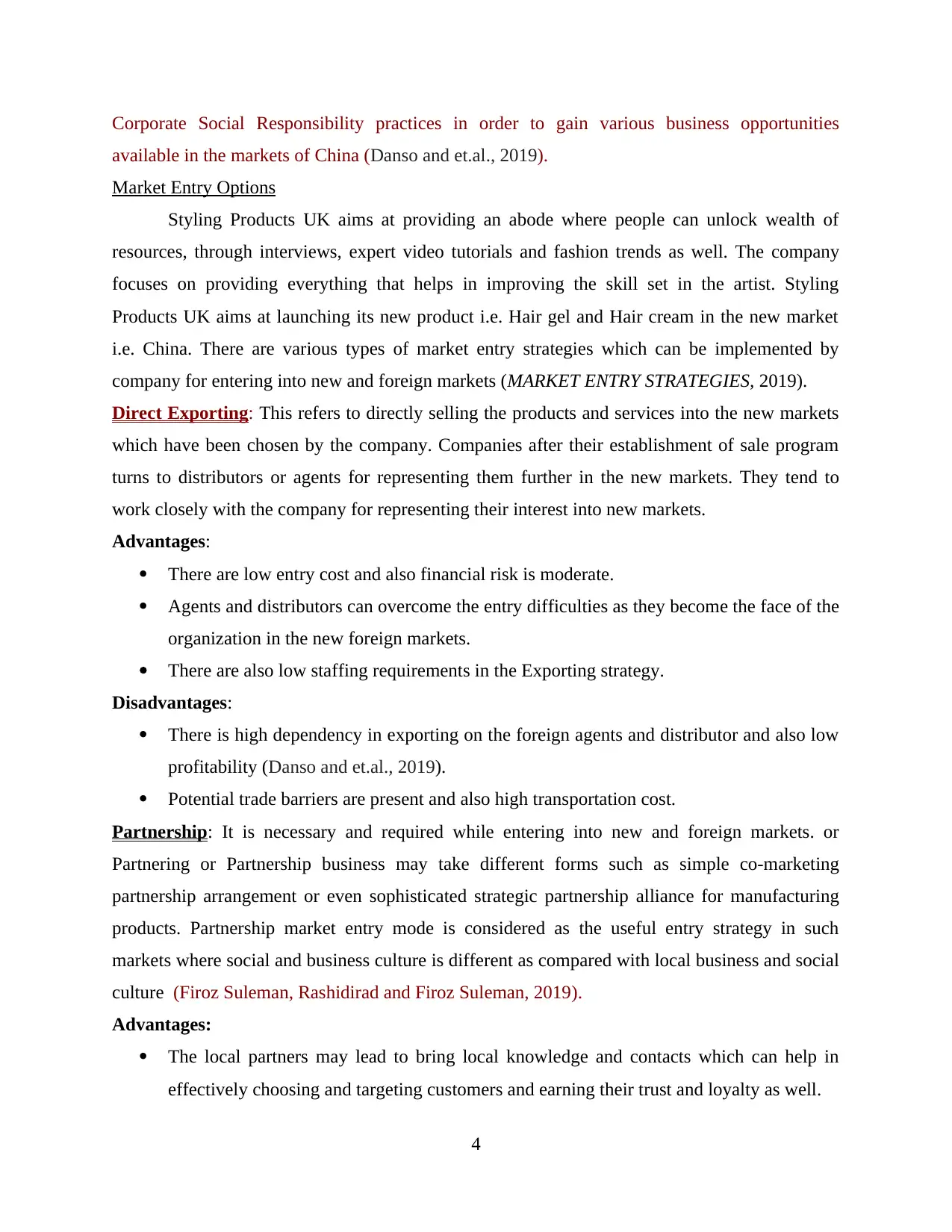
Corporate Social Responsibility practices in order to gain various business opportunities
available in the markets of China (Danso and et.al., 2019).
Market Entry Options
Styling Products UK aims at providing an abode where people can unlock wealth of
resources, through interviews, expert video tutorials and fashion trends as well. The company
focuses on providing everything that helps in improving the skill set in the artist. Styling
Products UK aims at launching its new product i.e. Hair gel and Hair cream in the new market
i.e. China. There are various types of market entry strategies which can be implemented by
company for entering into new and foreign markets (MARKET ENTRY STRATEGIES, 2019).
Direct Exporting: This refers to directly selling the products and services into the new markets
which have been chosen by the company. Companies after their establishment of sale program
turns to distributors or agents for representing them further in the new markets. They tend to
work closely with the company for representing their interest into new markets.
Advantages:
There are low entry cost and also financial risk is moderate.
Agents and distributors can overcome the entry difficulties as they become the face of the
organization in the new foreign markets.
There are also low staffing requirements in the Exporting strategy.
Disadvantages:
There is high dependency in exporting on the foreign agents and distributor and also low
profitability (Danso and et.al., 2019).
Potential trade barriers are present and also high transportation cost.
Partnership: It is necessary and required while entering into new and foreign markets. or
Partnering or Partnership business may take different forms such as simple co-marketing
partnership arrangement or even sophisticated strategic partnership alliance for manufacturing
products. Partnership market entry mode is considered as the useful entry strategy in such
markets where social and business culture is different as compared with local business and social
culture (Firoz Suleman, Rashidirad and Firoz Suleman, 2019).
Advantages:
The local partners may lead to bring local knowledge and contacts which can help in
effectively choosing and targeting customers and earning their trust and loyalty as well.
4
available in the markets of China (Danso and et.al., 2019).
Market Entry Options
Styling Products UK aims at providing an abode where people can unlock wealth of
resources, through interviews, expert video tutorials and fashion trends as well. The company
focuses on providing everything that helps in improving the skill set in the artist. Styling
Products UK aims at launching its new product i.e. Hair gel and Hair cream in the new market
i.e. China. There are various types of market entry strategies which can be implemented by
company for entering into new and foreign markets (MARKET ENTRY STRATEGIES, 2019).
Direct Exporting: This refers to directly selling the products and services into the new markets
which have been chosen by the company. Companies after their establishment of sale program
turns to distributors or agents for representing them further in the new markets. They tend to
work closely with the company for representing their interest into new markets.
Advantages:
There are low entry cost and also financial risk is moderate.
Agents and distributors can overcome the entry difficulties as they become the face of the
organization in the new foreign markets.
There are also low staffing requirements in the Exporting strategy.
Disadvantages:
There is high dependency in exporting on the foreign agents and distributor and also low
profitability (Danso and et.al., 2019).
Potential trade barriers are present and also high transportation cost.
Partnership: It is necessary and required while entering into new and foreign markets. or
Partnering or Partnership business may take different forms such as simple co-marketing
partnership arrangement or even sophisticated strategic partnership alliance for manufacturing
products. Partnership market entry mode is considered as the useful entry strategy in such
markets where social and business culture is different as compared with local business and social
culture (Firoz Suleman, Rashidirad and Firoz Suleman, 2019).
Advantages:
The local partners may lead to bring local knowledge and contacts which can help in
effectively choosing and targeting customers and earning their trust and loyalty as well.
4
Paraphrase This Document
Need a fresh take? Get an instant paraphrase of this document with our AI Paraphraser

Partnership business is extremely flexible and also easy to be established.
Disadvantages:
Liability of business partners regarding the business debts may be unlimited.
There may be disagreements in the process of decision-making.
Joint Venture: This is also considered as a form of partnership strategy as it involves
development of a new independently managed organization. According to this market entry
mode or strategy, Styling products UK and local company of China can work together by
creating and establishing a new company (Firoz Suleman, Rashidirad and Firoz Suleman, 2019).
Two organizations agrees for working together in certain markets, either geographically or
product, and they establish a third organization for undertaking this. Under the joint venture
mode, profits and risks are shared by the venturing companies.
Advantages:
There is a synergy effect because of the combination of skills and knowledge of local
partner and exporter.
Potential risk and losses can be shared between local partner and exporter company
(Hofer and Baba, 2018)..
Disadvantages:
There is high risk and also high entry cost in the joint venture strategy.
Complicated procedure needs to be followed for registration and potential conflicts may
even occur.
Buying a company: In some countries or markets, buying an existing company is considered as
the most appropriate market entry strategy. Government regulations may also restrict another
options for entering into new markets, thus, buying a company is the only option available to
some organization.
Advantages:
Existing company already have substantial share in the market and established customers
as well.
It is easy for obtaining finance due to the earlier proven track record.
Disadvantages:
Previous owner may have been got into unfavourable contractual obligations.
5
Disadvantages:
Liability of business partners regarding the business debts may be unlimited.
There may be disagreements in the process of decision-making.
Joint Venture: This is also considered as a form of partnership strategy as it involves
development of a new independently managed organization. According to this market entry
mode or strategy, Styling products UK and local company of China can work together by
creating and establishing a new company (Firoz Suleman, Rashidirad and Firoz Suleman, 2019).
Two organizations agrees for working together in certain markets, either geographically or
product, and they establish a third organization for undertaking this. Under the joint venture
mode, profits and risks are shared by the venturing companies.
Advantages:
There is a synergy effect because of the combination of skills and knowledge of local
partner and exporter.
Potential risk and losses can be shared between local partner and exporter company
(Hofer and Baba, 2018)..
Disadvantages:
There is high risk and also high entry cost in the joint venture strategy.
Complicated procedure needs to be followed for registration and potential conflicts may
even occur.
Buying a company: In some countries or markets, buying an existing company is considered as
the most appropriate market entry strategy. Government regulations may also restrict another
options for entering into new markets, thus, buying a company is the only option available to
some organization.
Advantages:
Existing company already have substantial share in the market and established customers
as well.
It is easy for obtaining finance due to the earlier proven track record.
Disadvantages:
Previous owner may have been got into unfavourable contractual obligations.
5

Previous business may have also created bad reputation which can further impact the new
business activities.
Styling products UK can choose the Direct exporting entry strategy for taking entry into
China markets as there are low entry cost and also moderate financial risk. There are also less
marketing cost and low requirements for staffing (Hofer and Baba, 2018). The company may
even choose joint venture strategy as there is the benefit of sharing of risk with the partner
company and also synergy effect is there. By directly exporting into China markets, company
will have following threats:
Direct exporting requires extra efforts for building a strong customer base and which may
take lot of time as well.
In the direct exporting no buffer zone is present. That means company is only the one
accountable and responsible for whatever happens (Howells and Lowe, 2018).
This requires extra energy, time, money and efforts which company may not afford in a
long run.
But, by entering into China markets through direct exporting, Styling Products can gain
following opportunities:
Company can develop better understanding of the markets by solely managing the
operations and it can effectively manage it in long run as well.
Direct exporting eliminates the intermediaries and that cost can increase the potential
profits of company.
Since there is no one accountable for the operations, company can have full control over
the products and services. And it can effectively determine the sales in accordance with
the competitive trends which prevails in the market.
Market Segmentation and Targeting
Market Segmentation
Market segmentation refers to the process of dividing the markets of potential customers
into the segments or groups in accordance with their characteristics (Moschis, Lee and Mathur,
2017). The segments which are created composes customers who generally share similar interest
and have similar needs or locations. They will also respond similarly to the marketing strategies
implemented by organizations. Customers are generally divided into groups based on their
6
business activities.
Styling products UK can choose the Direct exporting entry strategy for taking entry into
China markets as there are low entry cost and also moderate financial risk. There are also less
marketing cost and low requirements for staffing (Hofer and Baba, 2018). The company may
even choose joint venture strategy as there is the benefit of sharing of risk with the partner
company and also synergy effect is there. By directly exporting into China markets, company
will have following threats:
Direct exporting requires extra efforts for building a strong customer base and which may
take lot of time as well.
In the direct exporting no buffer zone is present. That means company is only the one
accountable and responsible for whatever happens (Howells and Lowe, 2018).
This requires extra energy, time, money and efforts which company may not afford in a
long run.
But, by entering into China markets through direct exporting, Styling Products can gain
following opportunities:
Company can develop better understanding of the markets by solely managing the
operations and it can effectively manage it in long run as well.
Direct exporting eliminates the intermediaries and that cost can increase the potential
profits of company.
Since there is no one accountable for the operations, company can have full control over
the products and services. And it can effectively determine the sales in accordance with
the competitive trends which prevails in the market.
Market Segmentation and Targeting
Market Segmentation
Market segmentation refers to the process of dividing the markets of potential customers
into the segments or groups in accordance with their characteristics (Moschis, Lee and Mathur,
2017). The segments which are created composes customers who generally share similar interest
and have similar needs or locations. They will also respond similarly to the marketing strategies
implemented by organizations. Customers are generally divided into groups based on their
6
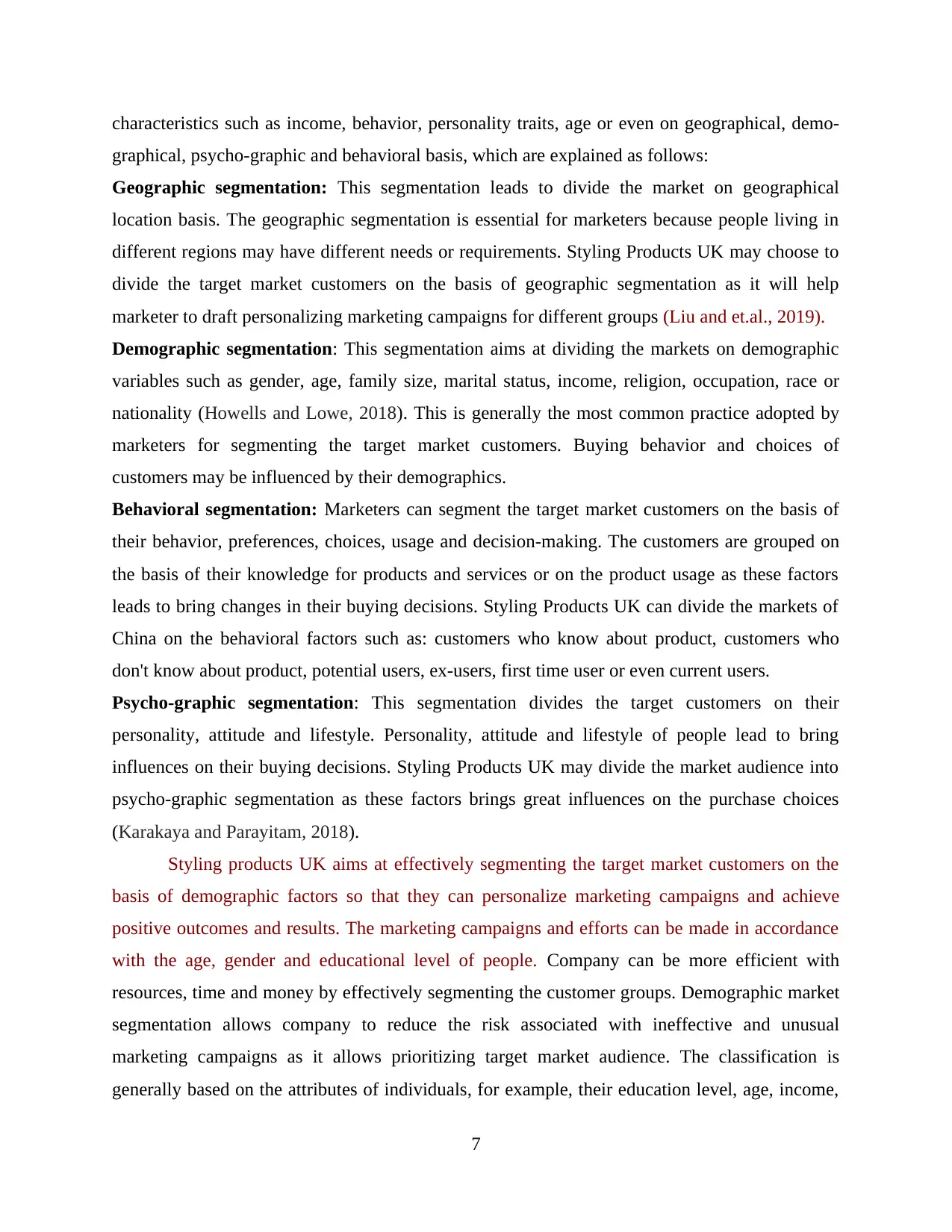
characteristics such as income, behavior, personality traits, age or even on geographical, demo-
graphical, psycho-graphic and behavioral basis, which are explained as follows:
Geographic segmentation: This segmentation leads to divide the market on geographical
location basis. The geographic segmentation is essential for marketers because people living in
different regions may have different needs or requirements. Styling Products UK may choose to
divide the target market customers on the basis of geographic segmentation as it will help
marketer to draft personalizing marketing campaigns for different groups (Liu and et.al., 2019).
Demographic segmentation: This segmentation aims at dividing the markets on demographic
variables such as gender, age, family size, marital status, income, religion, occupation, race or
nationality (Howells and Lowe, 2018). This is generally the most common practice adopted by
marketers for segmenting the target market customers. Buying behavior and choices of
customers may be influenced by their demographics.
Behavioral segmentation: Marketers can segment the target market customers on the basis of
their behavior, preferences, choices, usage and decision-making. The customers are grouped on
the basis of their knowledge for products and services or on the product usage as these factors
leads to bring changes in their buying decisions. Styling Products UK can divide the markets of
China on the behavioral factors such as: customers who know about product, customers who
don't know about product, potential users, ex-users, first time user or even current users.
Psycho-graphic segmentation: This segmentation divides the target customers on their
personality, attitude and lifestyle. Personality, attitude and lifestyle of people lead to bring
influences on their buying decisions. Styling Products UK may divide the market audience into
psycho-graphic segmentation as these factors brings great influences on the purchase choices
(Karakaya and Parayitam, 2018).
Styling products UK aims at effectively segmenting the target market customers on the
basis of demographic factors so that they can personalize marketing campaigns and achieve
positive outcomes and results. The marketing campaigns and efforts can be made in accordance
with the age, gender and educational level of people. Company can be more efficient with
resources, time and money by effectively segmenting the customer groups. Demographic market
segmentation allows company to reduce the risk associated with ineffective and unusual
marketing campaigns as it allows prioritizing target market audience. The classification is
generally based on the attributes of individuals, for example, their education level, age, income,
7
graphical, psycho-graphic and behavioral basis, which are explained as follows:
Geographic segmentation: This segmentation leads to divide the market on geographical
location basis. The geographic segmentation is essential for marketers because people living in
different regions may have different needs or requirements. Styling Products UK may choose to
divide the target market customers on the basis of geographic segmentation as it will help
marketer to draft personalizing marketing campaigns for different groups (Liu and et.al., 2019).
Demographic segmentation: This segmentation aims at dividing the markets on demographic
variables such as gender, age, family size, marital status, income, religion, occupation, race or
nationality (Howells and Lowe, 2018). This is generally the most common practice adopted by
marketers for segmenting the target market customers. Buying behavior and choices of
customers may be influenced by their demographics.
Behavioral segmentation: Marketers can segment the target market customers on the basis of
their behavior, preferences, choices, usage and decision-making. The customers are grouped on
the basis of their knowledge for products and services or on the product usage as these factors
leads to bring changes in their buying decisions. Styling Products UK can divide the markets of
China on the behavioral factors such as: customers who know about product, customers who
don't know about product, potential users, ex-users, first time user or even current users.
Psycho-graphic segmentation: This segmentation divides the target customers on their
personality, attitude and lifestyle. Personality, attitude and lifestyle of people lead to bring
influences on their buying decisions. Styling Products UK may divide the market audience into
psycho-graphic segmentation as these factors brings great influences on the purchase choices
(Karakaya and Parayitam, 2018).
Styling products UK aims at effectively segmenting the target market customers on the
basis of demographic factors so that they can personalize marketing campaigns and achieve
positive outcomes and results. The marketing campaigns and efforts can be made in accordance
with the age, gender and educational level of people. Company can be more efficient with
resources, time and money by effectively segmenting the customer groups. Demographic market
segmentation allows company to reduce the risk associated with ineffective and unusual
marketing campaigns as it allows prioritizing target market audience. The classification is
generally based on the attributes of individuals, for example, their education level, age, income,
7
Secure Best Marks with AI Grader
Need help grading? Try our AI Grader for instant feedback on your assignments.
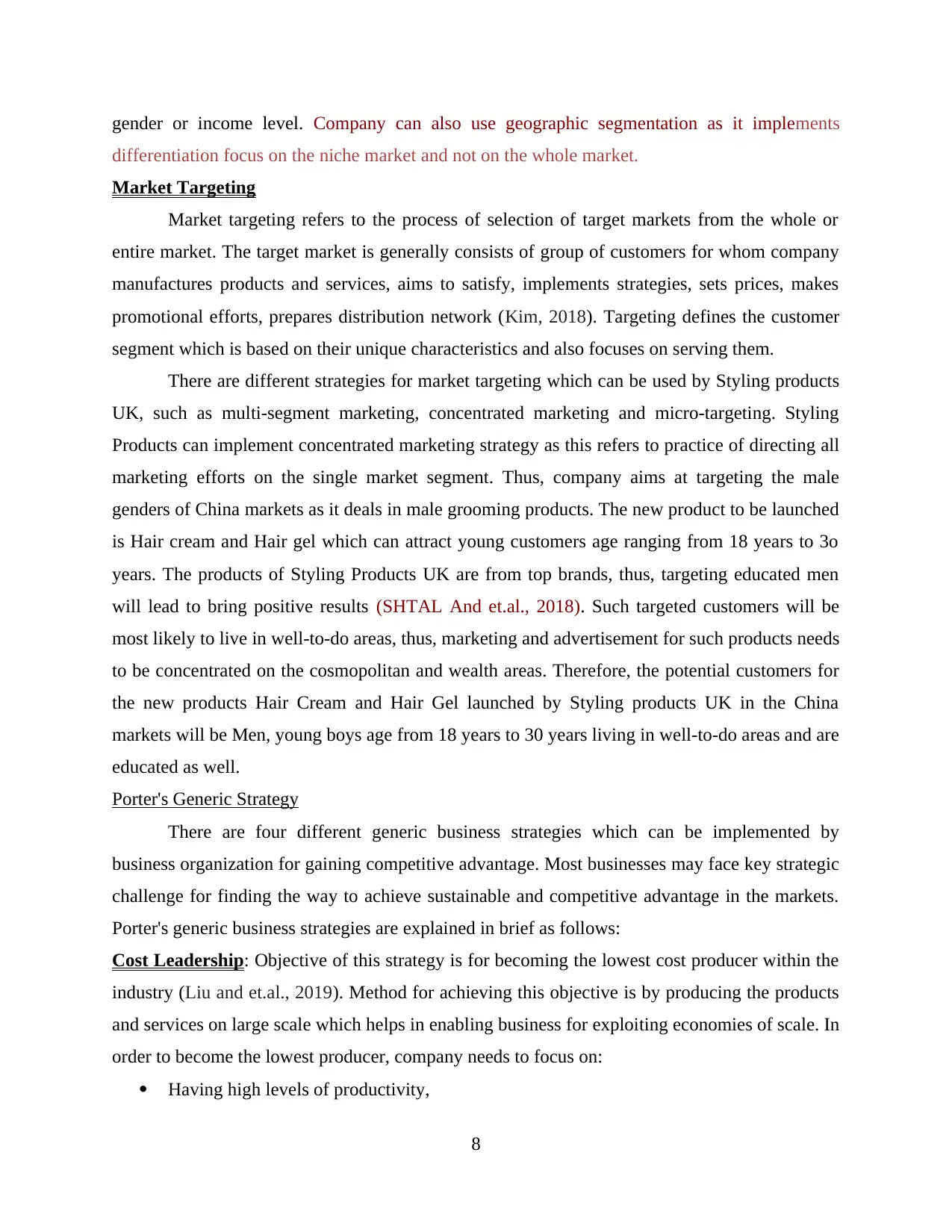
gender or income level. Company can also use geographic segmentation as it implements
differentiation focus on the niche market and not on the whole market.
Market Targeting
Market targeting refers to the process of selection of target markets from the whole or
entire market. The target market is generally consists of group of customers for whom company
manufactures products and services, aims to satisfy, implements strategies, sets prices, makes
promotional efforts, prepares distribution network (Kim, 2018). Targeting defines the customer
segment which is based on their unique characteristics and also focuses on serving them.
There are different strategies for market targeting which can be used by Styling products
UK, such as multi-segment marketing, concentrated marketing and micro-targeting. Styling
Products can implement concentrated marketing strategy as this refers to practice of directing all
marketing efforts on the single market segment. Thus, company aims at targeting the male
genders of China markets as it deals in male grooming products. The new product to be launched
is Hair cream and Hair gel which can attract young customers age ranging from 18 years to 3o
years. The products of Styling Products UK are from top brands, thus, targeting educated men
will lead to bring positive results (SHTAL And et.al., 2018). Such targeted customers will be
most likely to live in well-to-do areas, thus, marketing and advertisement for such products needs
to be concentrated on the cosmopolitan and wealth areas. Therefore, the potential customers for
the new products Hair Cream and Hair Gel launched by Styling products UK in the China
markets will be Men, young boys age from 18 years to 30 years living in well-to-do areas and are
educated as well.
Porter's Generic Strategy
There are four different generic business strategies which can be implemented by
business organization for gaining competitive advantage. Most businesses may face key strategic
challenge for finding the way to achieve sustainable and competitive advantage in the markets.
Porter's generic business strategies are explained in brief as follows:
Cost Leadership: Objective of this strategy is for becoming the lowest cost producer within the
industry (Liu and et.al., 2019). Method for achieving this objective is by producing the products
and services on large scale which helps in enabling business for exploiting economies of scale. In
order to become the lowest producer, company needs to focus on:
Having high levels of productivity,
8
differentiation focus on the niche market and not on the whole market.
Market Targeting
Market targeting refers to the process of selection of target markets from the whole or
entire market. The target market is generally consists of group of customers for whom company
manufactures products and services, aims to satisfy, implements strategies, sets prices, makes
promotional efforts, prepares distribution network (Kim, 2018). Targeting defines the customer
segment which is based on their unique characteristics and also focuses on serving them.
There are different strategies for market targeting which can be used by Styling products
UK, such as multi-segment marketing, concentrated marketing and micro-targeting. Styling
Products can implement concentrated marketing strategy as this refers to practice of directing all
marketing efforts on the single market segment. Thus, company aims at targeting the male
genders of China markets as it deals in male grooming products. The new product to be launched
is Hair cream and Hair gel which can attract young customers age ranging from 18 years to 3o
years. The products of Styling Products UK are from top brands, thus, targeting educated men
will lead to bring positive results (SHTAL And et.al., 2018). Such targeted customers will be
most likely to live in well-to-do areas, thus, marketing and advertisement for such products needs
to be concentrated on the cosmopolitan and wealth areas. Therefore, the potential customers for
the new products Hair Cream and Hair Gel launched by Styling products UK in the China
markets will be Men, young boys age from 18 years to 30 years living in well-to-do areas and are
educated as well.
Porter's Generic Strategy
There are four different generic business strategies which can be implemented by
business organization for gaining competitive advantage. Most businesses may face key strategic
challenge for finding the way to achieve sustainable and competitive advantage in the markets.
Porter's generic business strategies are explained in brief as follows:
Cost Leadership: Objective of this strategy is for becoming the lowest cost producer within the
industry (Liu and et.al., 2019). Method for achieving this objective is by producing the products
and services on large scale which helps in enabling business for exploiting economies of scale. In
order to become the lowest producer, company needs to focus on:
Having high levels of productivity,
8
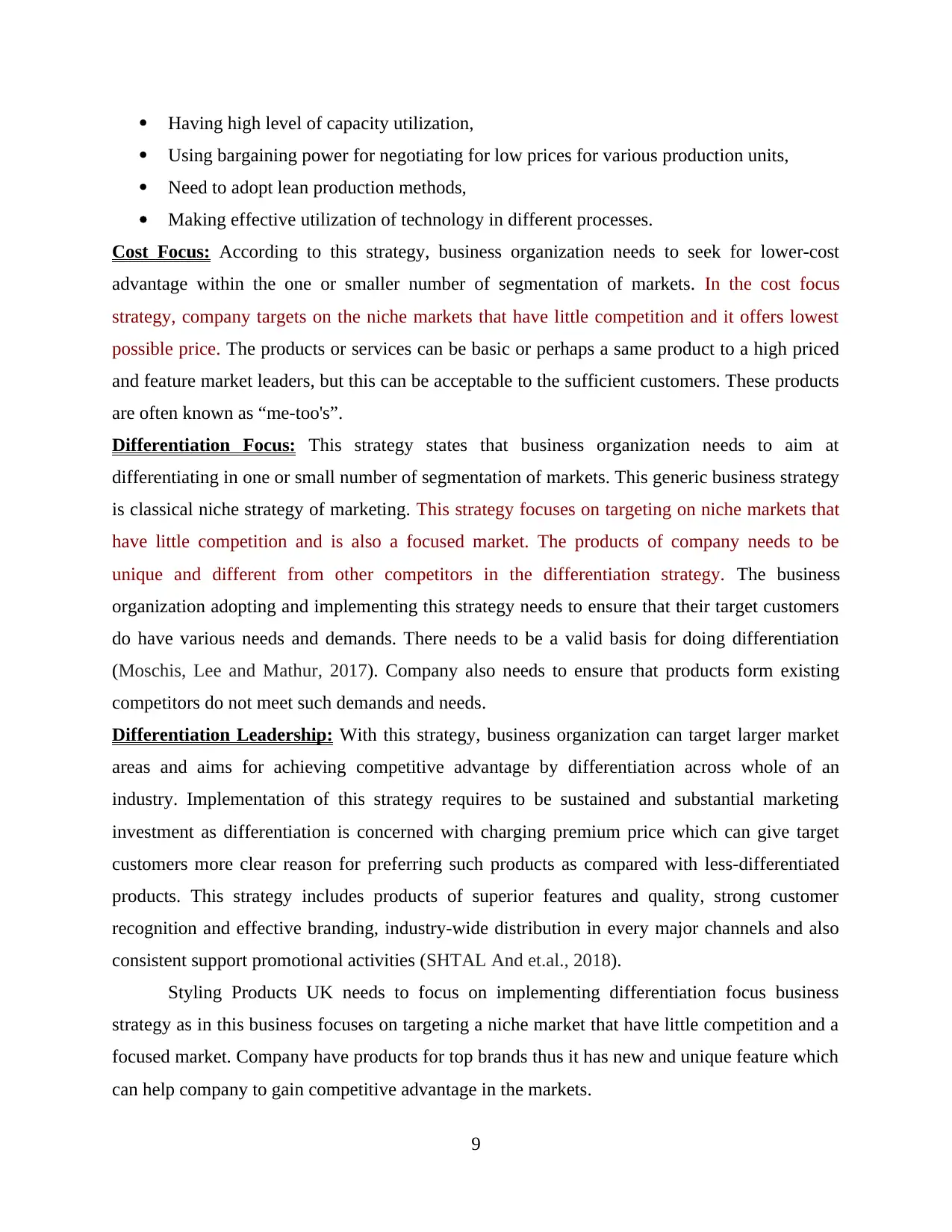
Having high level of capacity utilization,
Using bargaining power for negotiating for low prices for various production units,
Need to adopt lean production methods,
Making effective utilization of technology in different processes.
Cost Focus: According to this strategy, business organization needs to seek for lower-cost
advantage within the one or smaller number of segmentation of markets. In the cost focus
strategy, company targets on the niche markets that have little competition and it offers lowest
possible price. The products or services can be basic or perhaps a same product to a high priced
and feature market leaders, but this can be acceptable to the sufficient customers. These products
are often known as “me-too's”.
Differentiation Focus: This strategy states that business organization needs to aim at
differentiating in one or small number of segmentation of markets. This generic business strategy
is classical niche strategy of marketing. This strategy focuses on targeting on niche markets that
have little competition and is also a focused market. The products of company needs to be
unique and different from other competitors in the differentiation strategy. The business
organization adopting and implementing this strategy needs to ensure that their target customers
do have various needs and demands. There needs to be a valid basis for doing differentiation
(Moschis, Lee and Mathur, 2017). Company also needs to ensure that products form existing
competitors do not meet such demands and needs.
Differentiation Leadership: With this strategy, business organization can target larger market
areas and aims for achieving competitive advantage by differentiation across whole of an
industry. Implementation of this strategy requires to be sustained and substantial marketing
investment as differentiation is concerned with charging premium price which can give target
customers more clear reason for preferring such products as compared with less-differentiated
products. This strategy includes products of superior features and quality, strong customer
recognition and effective branding, industry-wide distribution in every major channels and also
consistent support promotional activities (SHTAL And et.al., 2018).
Styling Products UK needs to focus on implementing differentiation focus business
strategy as in this business focuses on targeting a niche market that have little competition and a
focused market. Company have products for top brands thus it has new and unique feature which
can help company to gain competitive advantage in the markets.
9
Using bargaining power for negotiating for low prices for various production units,
Need to adopt lean production methods,
Making effective utilization of technology in different processes.
Cost Focus: According to this strategy, business organization needs to seek for lower-cost
advantage within the one or smaller number of segmentation of markets. In the cost focus
strategy, company targets on the niche markets that have little competition and it offers lowest
possible price. The products or services can be basic or perhaps a same product to a high priced
and feature market leaders, but this can be acceptable to the sufficient customers. These products
are often known as “me-too's”.
Differentiation Focus: This strategy states that business organization needs to aim at
differentiating in one or small number of segmentation of markets. This generic business strategy
is classical niche strategy of marketing. This strategy focuses on targeting on niche markets that
have little competition and is also a focused market. The products of company needs to be
unique and different from other competitors in the differentiation strategy. The business
organization adopting and implementing this strategy needs to ensure that their target customers
do have various needs and demands. There needs to be a valid basis for doing differentiation
(Moschis, Lee and Mathur, 2017). Company also needs to ensure that products form existing
competitors do not meet such demands and needs.
Differentiation Leadership: With this strategy, business organization can target larger market
areas and aims for achieving competitive advantage by differentiation across whole of an
industry. Implementation of this strategy requires to be sustained and substantial marketing
investment as differentiation is concerned with charging premium price which can give target
customers more clear reason for preferring such products as compared with less-differentiated
products. This strategy includes products of superior features and quality, strong customer
recognition and effective branding, industry-wide distribution in every major channels and also
consistent support promotional activities (SHTAL And et.al., 2018).
Styling Products UK needs to focus on implementing differentiation focus business
strategy as in this business focuses on targeting a niche market that have little competition and a
focused market. Company have products for top brands thus it has new and unique feature which
can help company to gain competitive advantage in the markets.
9
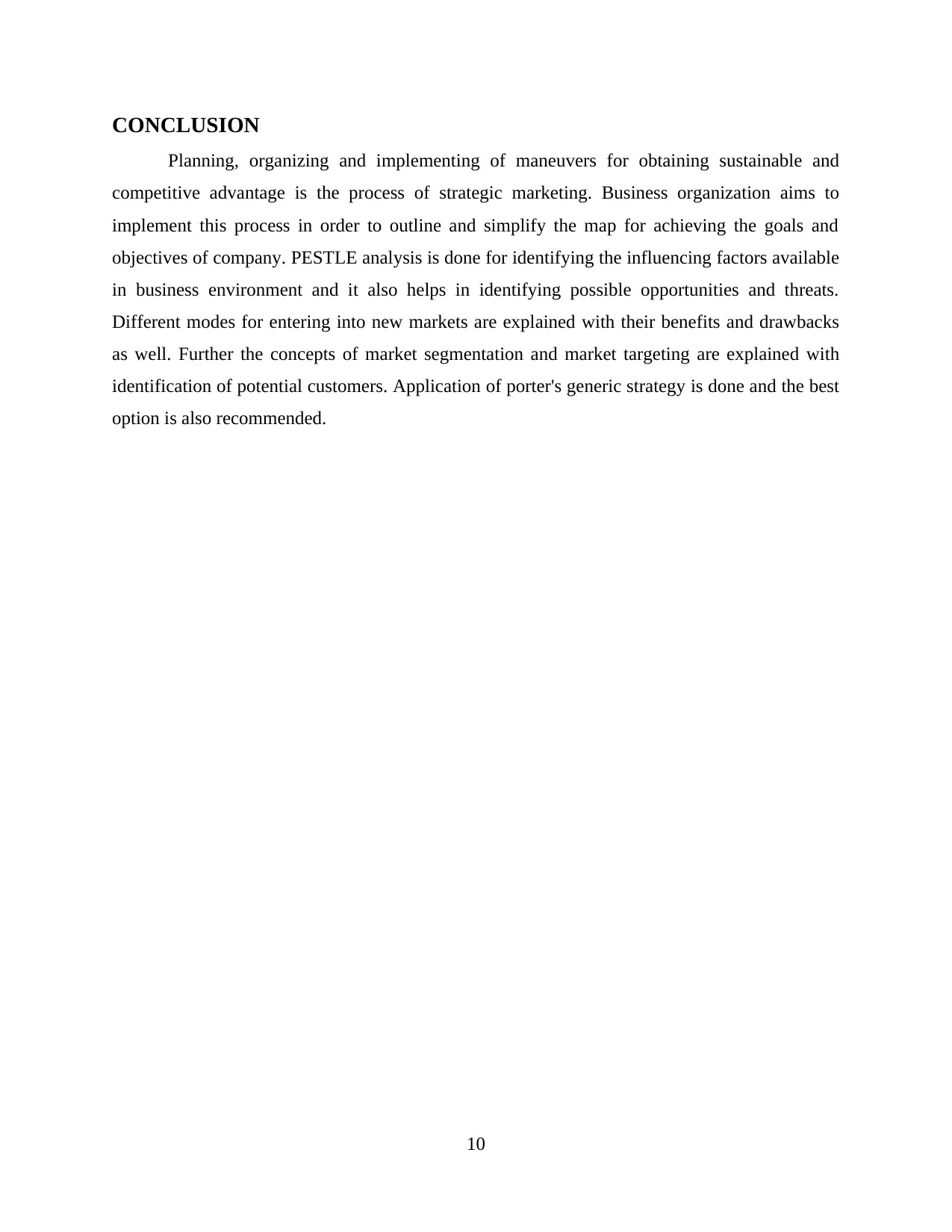
CONCLUSION
Planning, organizing and implementing of maneuvers for obtaining sustainable and
competitive advantage is the process of strategic marketing. Business organization aims to
implement this process in order to outline and simplify the map for achieving the goals and
objectives of company. PESTLE analysis is done for identifying the influencing factors available
in business environment and it also helps in identifying possible opportunities and threats.
Different modes for entering into new markets are explained with their benefits and drawbacks
as well. Further the concepts of market segmentation and market targeting are explained with
identification of potential customers. Application of porter's generic strategy is done and the best
option is also recommended.
10
Planning, organizing and implementing of maneuvers for obtaining sustainable and
competitive advantage is the process of strategic marketing. Business organization aims to
implement this process in order to outline and simplify the map for achieving the goals and
objectives of company. PESTLE analysis is done for identifying the influencing factors available
in business environment and it also helps in identifying possible opportunities and threats.
Different modes for entering into new markets are explained with their benefits and drawbacks
as well. Further the concepts of market segmentation and market targeting are explained with
identification of potential customers. Application of porter's generic strategy is done and the best
option is also recommended.
10
Paraphrase This Document
Need a fresh take? Get an instant paraphrase of this document with our AI Paraphraser
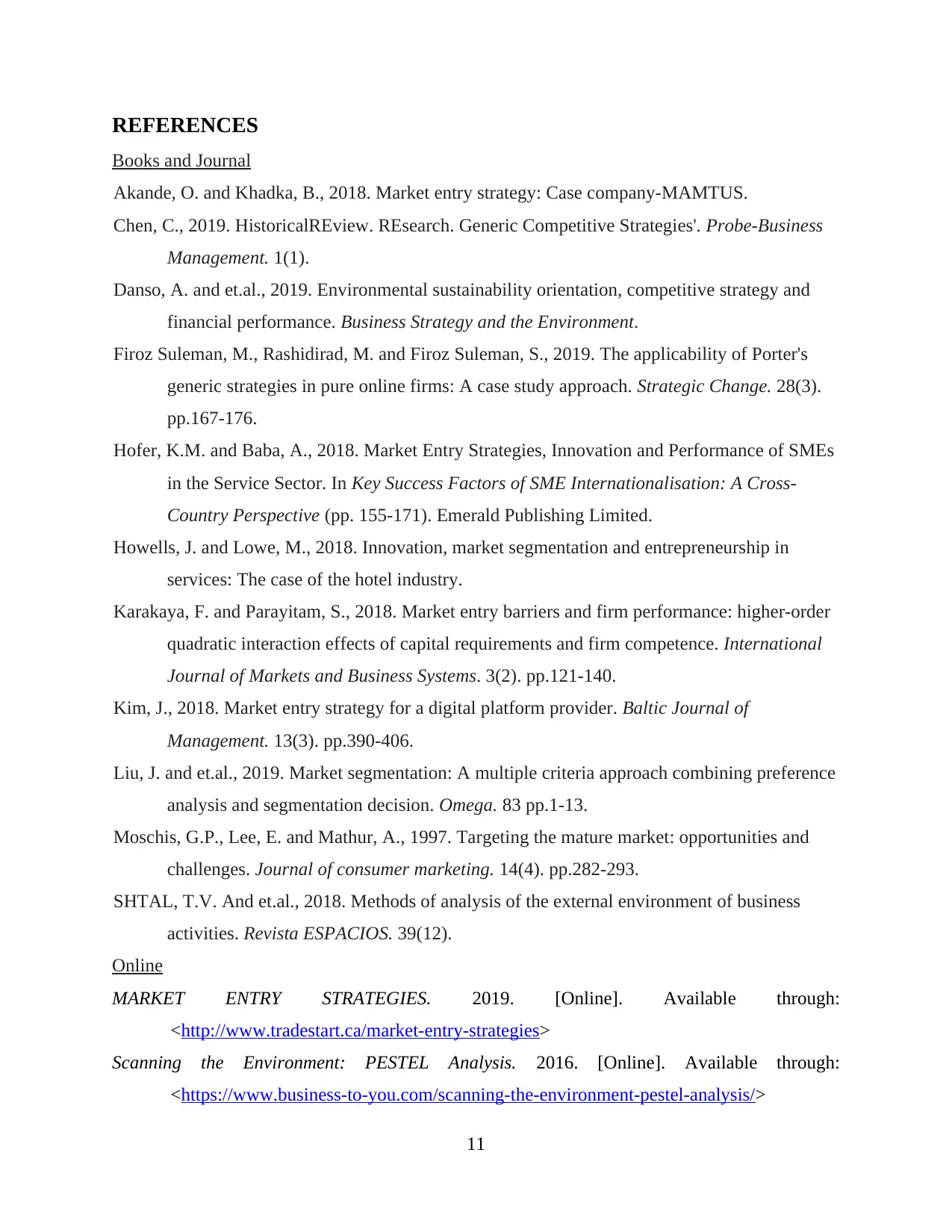
REFERENCES
Books and Journal
Akande, O. and Khadka, B., 2018. Market entry strategy: Case company-MAMTUS.
Chen, C., 2019. HistoricalREview. REsearch. Generic Competitive Strategies'. Probe-Business
Management. 1(1).
Danso, A. and et.al., 2019. Environmental sustainability orientation, competitive strategy and
financial performance. Business Strategy and the Environment.
Firoz Suleman, M., Rashidirad, M. and Firoz Suleman, S., 2019. The applicability of Porter's
generic strategies in pure online firms: A case study approach. Strategic Change. 28(3).
pp.167-176.
Hofer, K.M. and Baba, A., 2018. Market Entry Strategies, Innovation and Performance of SMEs
in the Service Sector. In Key Success Factors of SME Internationalisation: A Cross-
Country Perspective (pp. 155-171). Emerald Publishing Limited.
Howells, J. and Lowe, M., 2018. Innovation, market segmentation and entrepreneurship in
services: The case of the hotel industry.
Karakaya, F. and Parayitam, S., 2018. Market entry barriers and firm performance: higher-order
quadratic interaction effects of capital requirements and firm competence. International
Journal of Markets and Business Systems. 3(2). pp.121-140.
Kim, J., 2018. Market entry strategy for a digital platform provider. Baltic Journal of
Management. 13(3). pp.390-406.
Liu, J. and et.al., 2019. Market segmentation: A multiple criteria approach combining preference
analysis and segmentation decision. Omega. 83 pp.1-13.
Moschis, G.P., Lee, E. and Mathur, A., 1997. Targeting the mature market: opportunities and
challenges. Journal of consumer marketing. 14(4). pp.282-293.
SHTAL, T.V. And et.al., 2018. Methods of analysis of the external environment of business
activities. Revista ESPACIOS. 39(12).
Online
MARKET ENTRY STRATEGIES. 2019. [Online]. Available through:
<http://www.tradestart.ca/market-entry-strategies>
Scanning the Environment: PESTEL Analysis. 2016. [Online]. Available through:
<https://www.business-to-you.com/scanning-the-environment-pestel-analysis/>
11
Books and Journal
Akande, O. and Khadka, B., 2018. Market entry strategy: Case company-MAMTUS.
Chen, C., 2019. HistoricalREview. REsearch. Generic Competitive Strategies'. Probe-Business
Management. 1(1).
Danso, A. and et.al., 2019. Environmental sustainability orientation, competitive strategy and
financial performance. Business Strategy and the Environment.
Firoz Suleman, M., Rashidirad, M. and Firoz Suleman, S., 2019. The applicability of Porter's
generic strategies in pure online firms: A case study approach. Strategic Change. 28(3).
pp.167-176.
Hofer, K.M. and Baba, A., 2018. Market Entry Strategies, Innovation and Performance of SMEs
in the Service Sector. In Key Success Factors of SME Internationalisation: A Cross-
Country Perspective (pp. 155-171). Emerald Publishing Limited.
Howells, J. and Lowe, M., 2018. Innovation, market segmentation and entrepreneurship in
services: The case of the hotel industry.
Karakaya, F. and Parayitam, S., 2018. Market entry barriers and firm performance: higher-order
quadratic interaction effects of capital requirements and firm competence. International
Journal of Markets and Business Systems. 3(2). pp.121-140.
Kim, J., 2018. Market entry strategy for a digital platform provider. Baltic Journal of
Management. 13(3). pp.390-406.
Liu, J. and et.al., 2019. Market segmentation: A multiple criteria approach combining preference
analysis and segmentation decision. Omega. 83 pp.1-13.
Moschis, G.P., Lee, E. and Mathur, A., 1997. Targeting the mature market: opportunities and
challenges. Journal of consumer marketing. 14(4). pp.282-293.
SHTAL, T.V. And et.al., 2018. Methods of analysis of the external environment of business
activities. Revista ESPACIOS. 39(12).
Online
MARKET ENTRY STRATEGIES. 2019. [Online]. Available through:
<http://www.tradestart.ca/market-entry-strategies>
Scanning the Environment: PESTEL Analysis. 2016. [Online]. Available through:
<https://www.business-to-you.com/scanning-the-environment-pestel-analysis/>
11

12
1 out of 15
Related Documents
Your All-in-One AI-Powered Toolkit for Academic Success.
+13062052269
info@desklib.com
Available 24*7 on WhatsApp / Email
![[object Object]](/_next/static/media/star-bottom.7253800d.svg)
Unlock your academic potential
© 2024 | Zucol Services PVT LTD | All rights reserved.




